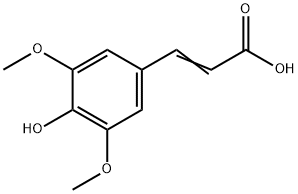All AbMole products are for research use only, cannot be used for human consumption.

Sinapinic acid (Sinapic acid) is derived from Hydnophytum formicarum Jack. The phenolic compounds isolated from the roots were inhibitors of HDAC with an IC50 value of 2.27 mM and also inhibited the activity of AC-I. Sinapinic acid has effective antitumor activity and can induce apoptosis of tumor cells. Sinapinic acid has antioxidant and anti - diabetic effects. Sinapinic acid can reduce total cholesterol, triglyceride and HOMA-IR index in ovariectomized rats, and normalize some serum parameters of antioxidant capacity and oxidative damage.
| Molecular Weight | 224.21 |
| Formula | C11H12O5 |
| CAS Number | 530-59-6 |
| Solubility (25°C) | DMSO ≥ 40 mg/mL |
| Storage |
Powder -20°C 3 years ; 4°C 2 years In solvent -80°C 6 months ; -20°C 1 month |
| Related HDAC Products |
|---|
| CM-444
CM-444 is an inhibitor for HDAC and DNA methyltransferases (DNMT) with IC50 values of 6 nM-0.6 μM and 1.8-2.3 μM, respectively. CM-444 is an inducer for the differentiation of acute myeloid leukemia cells. CM-444 exhibits anti-leukemic activity and improves the survival rate in mouse models. |
| CM-1758
CM-1758 is a histone deacetylase (HDAC) inhibitor. CM-1758 inhibits tumor growth in vivo. CM-1758 induces acetylation of non-histone proteins in acute myeloid leukemia cells. |
| T-518
T-518 is an orally active, selective, and blood-brain barrier permeable HDAC6 inhibitor with an IC50 value of 36 nM for human HDAC6. |
| SE-7552
SE-7552, a 2-(difluoromethyl)-1,3,4-oxadiazole (DFMO) derivative, is an orally active, highly selective, non-hydroxamate HDAC6 inhibitor with an IC50 of 33 nM. |
| BRD9757
BRD9757 is a potent, capless and selective HDAC6 inhibitor with an IC50 of 30 nM. |
All AbMole products are for research use only, cannot be used for human consumption or veterinary use. We do not provide products or services to individuals. Please comply with the intended use and do not use AbMole products for any other purpose.


Products are for research use only. Not for human use. We do not sell to patients.
© Copyright 2010-2024 AbMole BioScience. All Rights Reserved.
